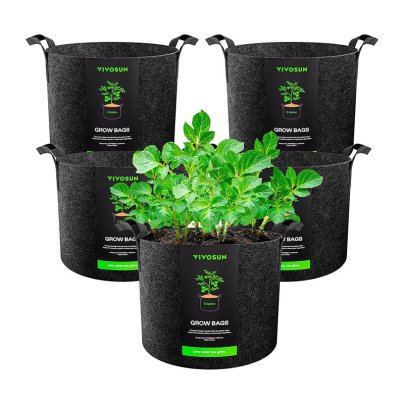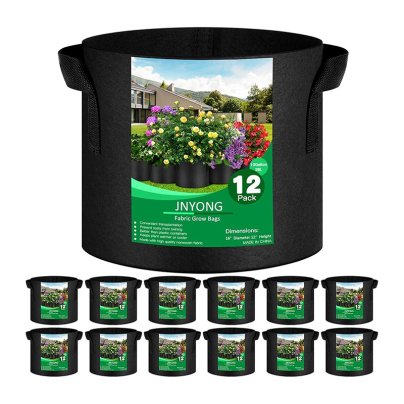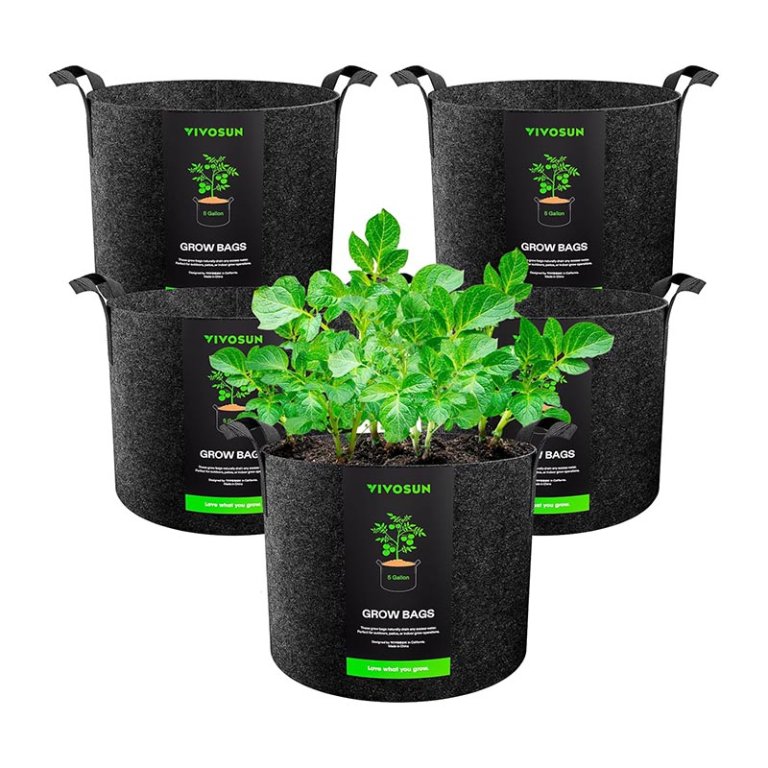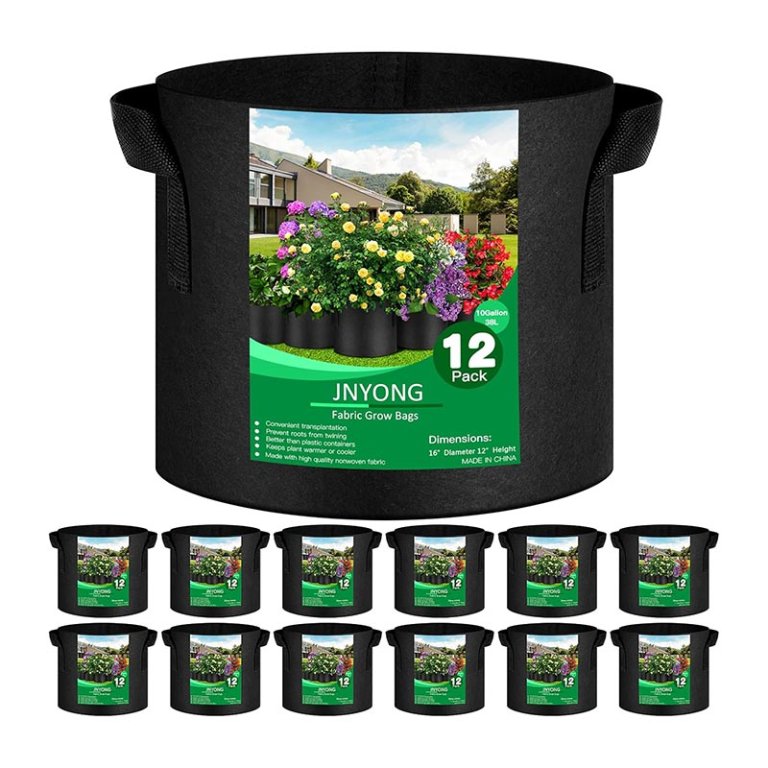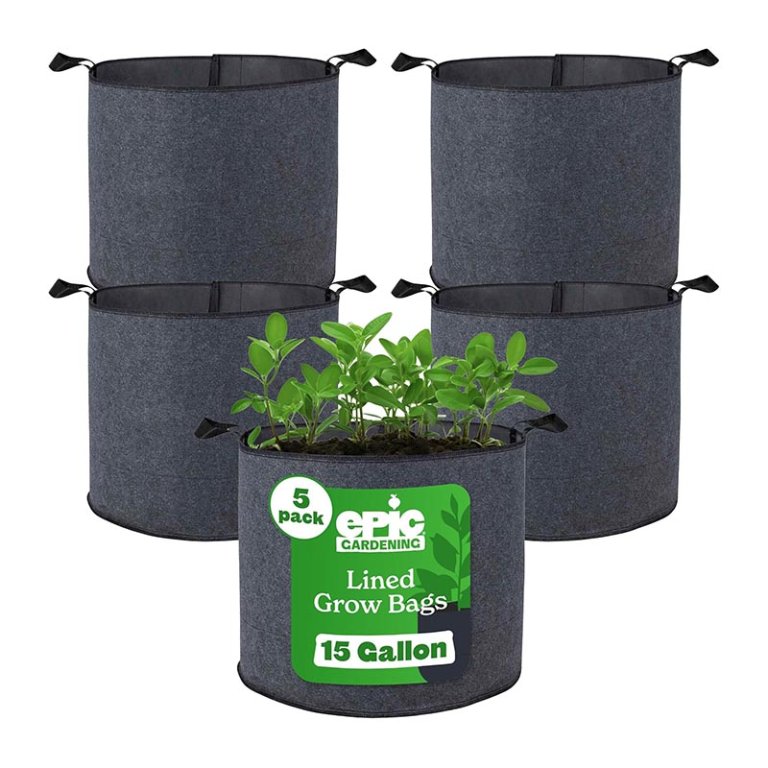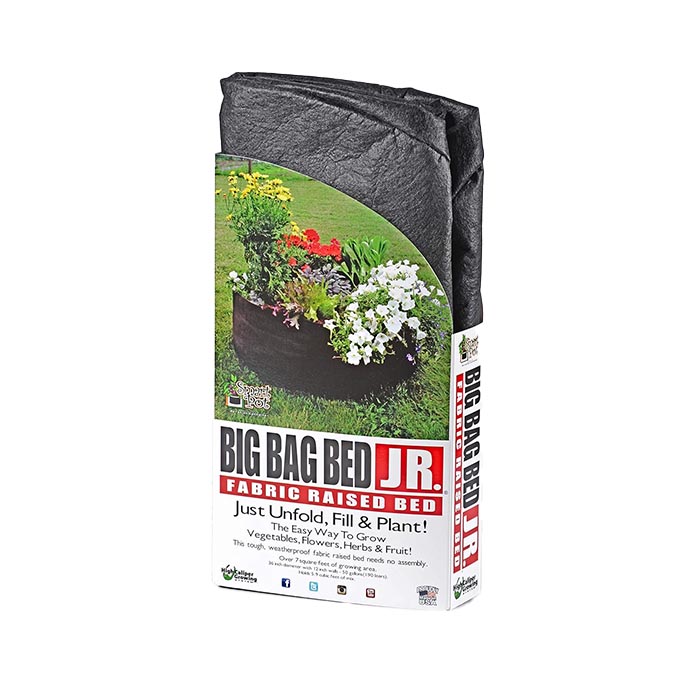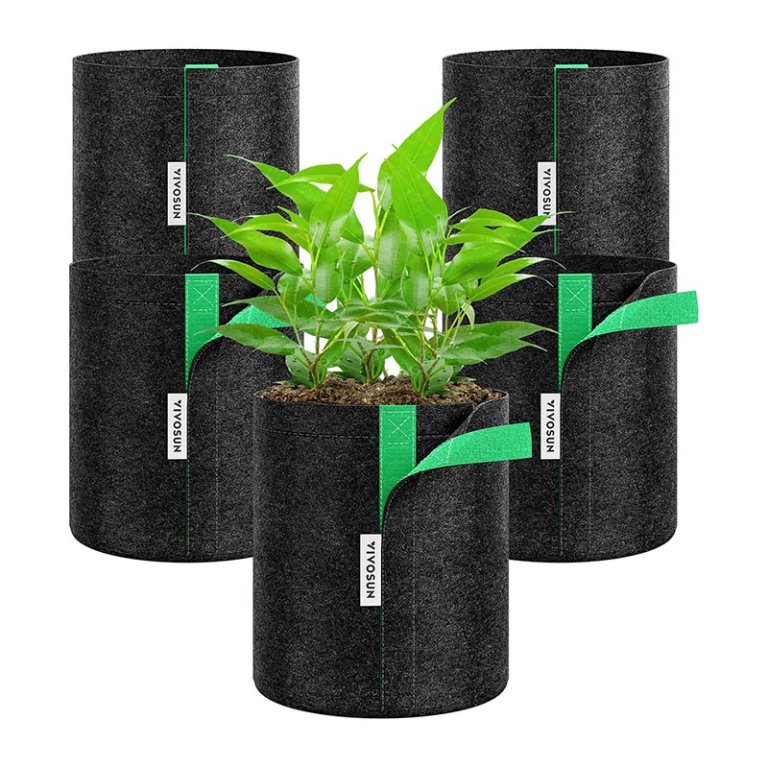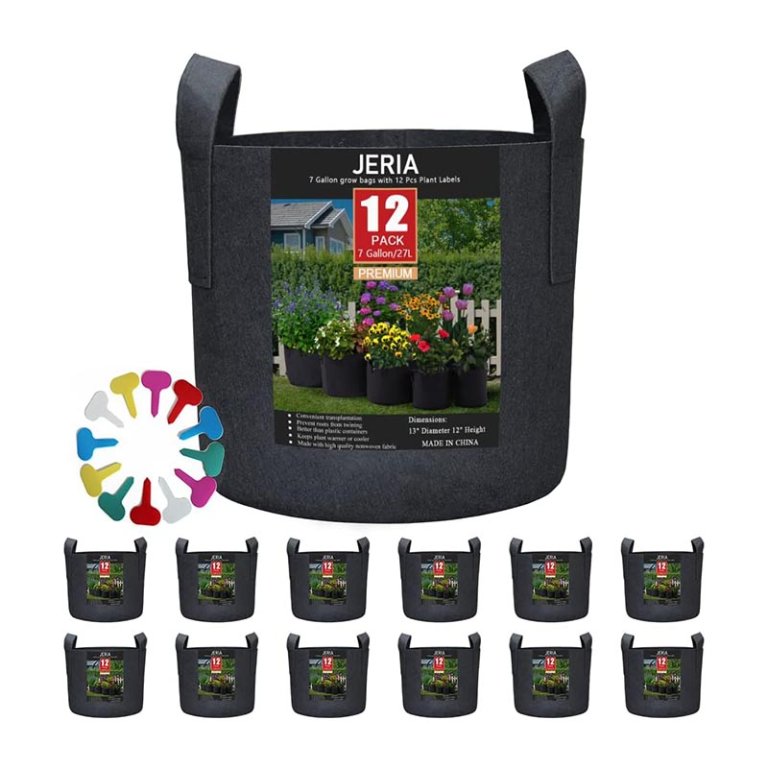
We may earn revenue from the products available on this page and participate in affiliate programs. Learn More ›
Grow bags are a smart, space-saving option for gardeners of all skill levels. Whether you’re growing herbs on a balcony, starting seeds indoors, or planting vegetables in an area with poor soil, grow bags offer a flexible, low-maintenance solution. We tested four top-rated grow bags to help you find the right one for your needs.
A quality grow bag can make a big difference. Good airflow, sturdy handles, and durable fabric all contribute to healthier root systems and easier gardening. With so many options out there, choosing a well-made bag means you’ll spend less time fussing with tools and more time enjoying your plants.
While we tested four grow bags hands-on, there are several others that look promising and could be worth a try. Our favorite? The Vivosun 5-Gallon Nonwoven Fabric Grow Bags. They strike a great balance between durability and affordability—perfect for seasonal plantings as well as short-term setups.
We’ll walk you through what to look for in the best grow bags, from size and fabric quality to drainage and portability.
- BEST OVERALL: Vivosun 5-Gallon Nonwoven Fabric Grow Bags
↓ Jump to Review - BEST BANG FOR THE BUCK: Jnyong 12-Pack 10-Gallon Nonwoven Grow Bags
↓ Jump to Review - UPGRADE PICK: Epic Gardening Lined Grow Bags
↓ Jump to Review - BEST LARGE: Smart Pots Big Bag Bed Fabric Raised Planting Bed
↓ Jump to Review - BEST SMALL: Vivosun 1-Gallon Grow Bags with Self-Adhesion Sides
↓ Jump to Review - BEST IN BULK: Jeria 12-Pack 7-Gallon Vegetable/Flower/Plant Bags
↓ Jump to Review
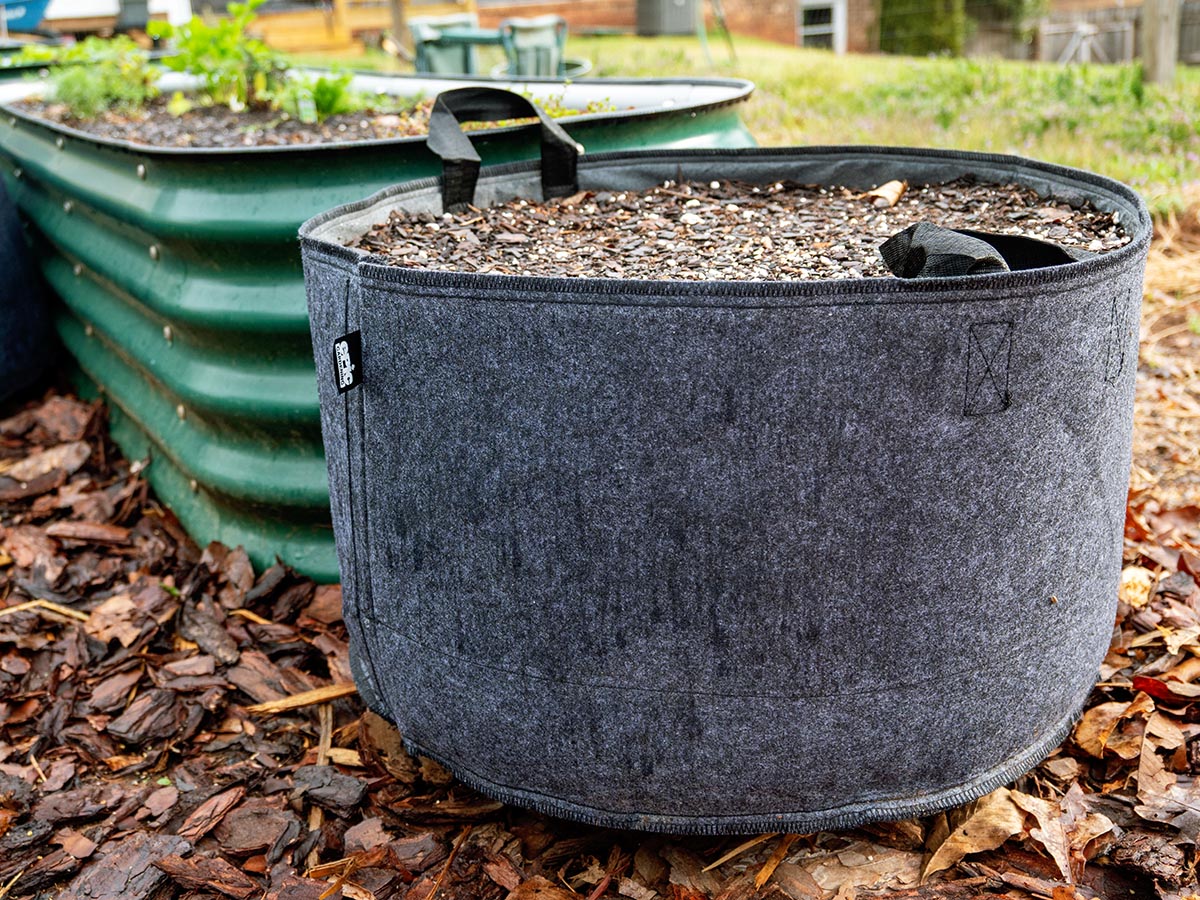
| Material | Dimensions | Capacity | |
| Vivosun 5-Gallon Nonwoven Fabric Grow Bags | 300g Nonwoven fabric | 12.5 inches high by 9.9 inches wide | 5 gallons |
| Jnyong 12-Pack 10-Gallon Nonwoven Grow Bags | Nonwoven fabric | 12 inches high by 16 inches wide | 10 gallons |
| Epic Gardening Lined Grow Bags | Recycled PET felt | 11.75 inches high by 19.5 inches wide | 15 gallons |
| Smart Pots Big Bag Bed Fabric Raised Planting Bed | Nonwoven polypropylene fabric | 12 inches high by 36 inches wide | 50 gallons |
| Vivosun 1-Gallon Grow Bags with Self-Adhesion Sides | Nonwoven fabric | 7.9 inches high by 6.3 inches wide | 1 gallon |
| Jeria 12-Pack 7-Gallon Vegetable/Flower/Plant Bags | Not Listed | 12 inches high by 13 inches wide | 7 gallons |
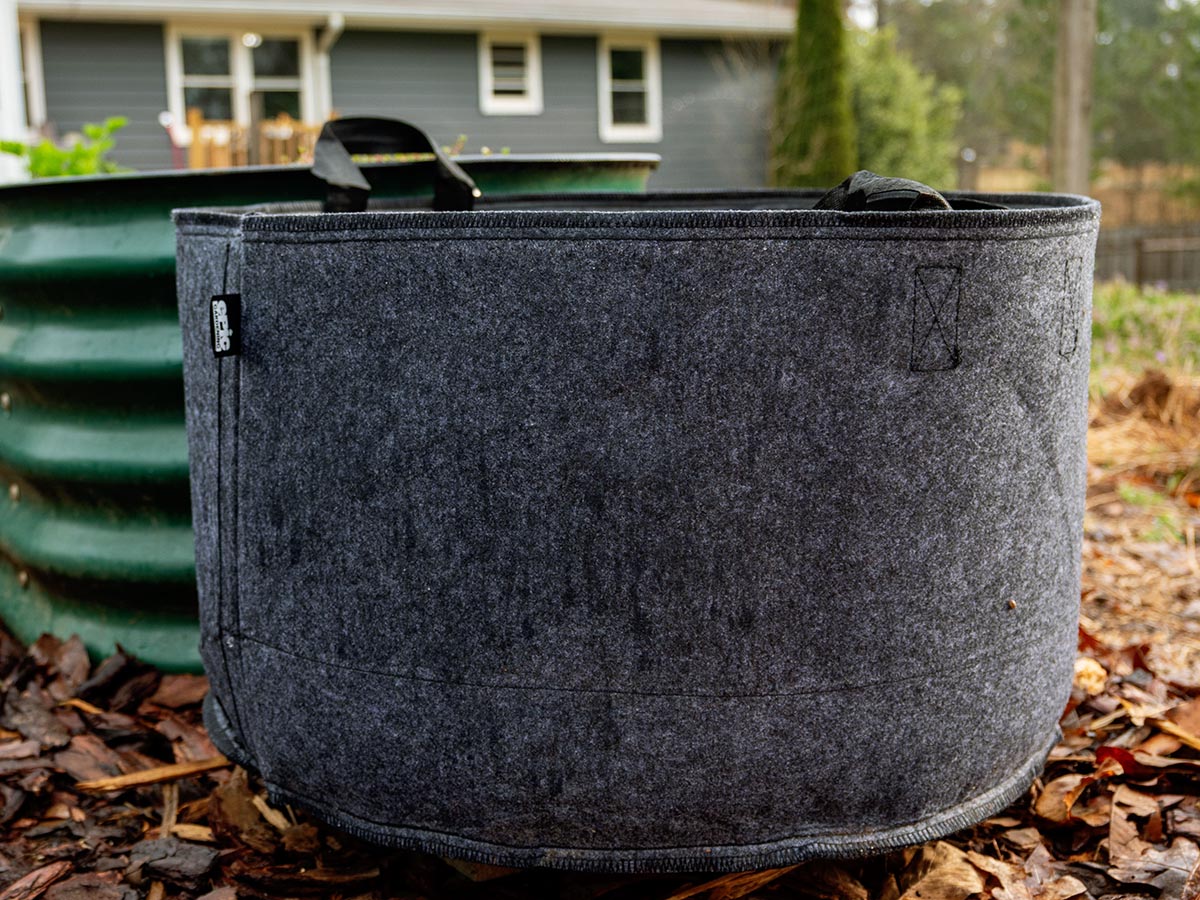
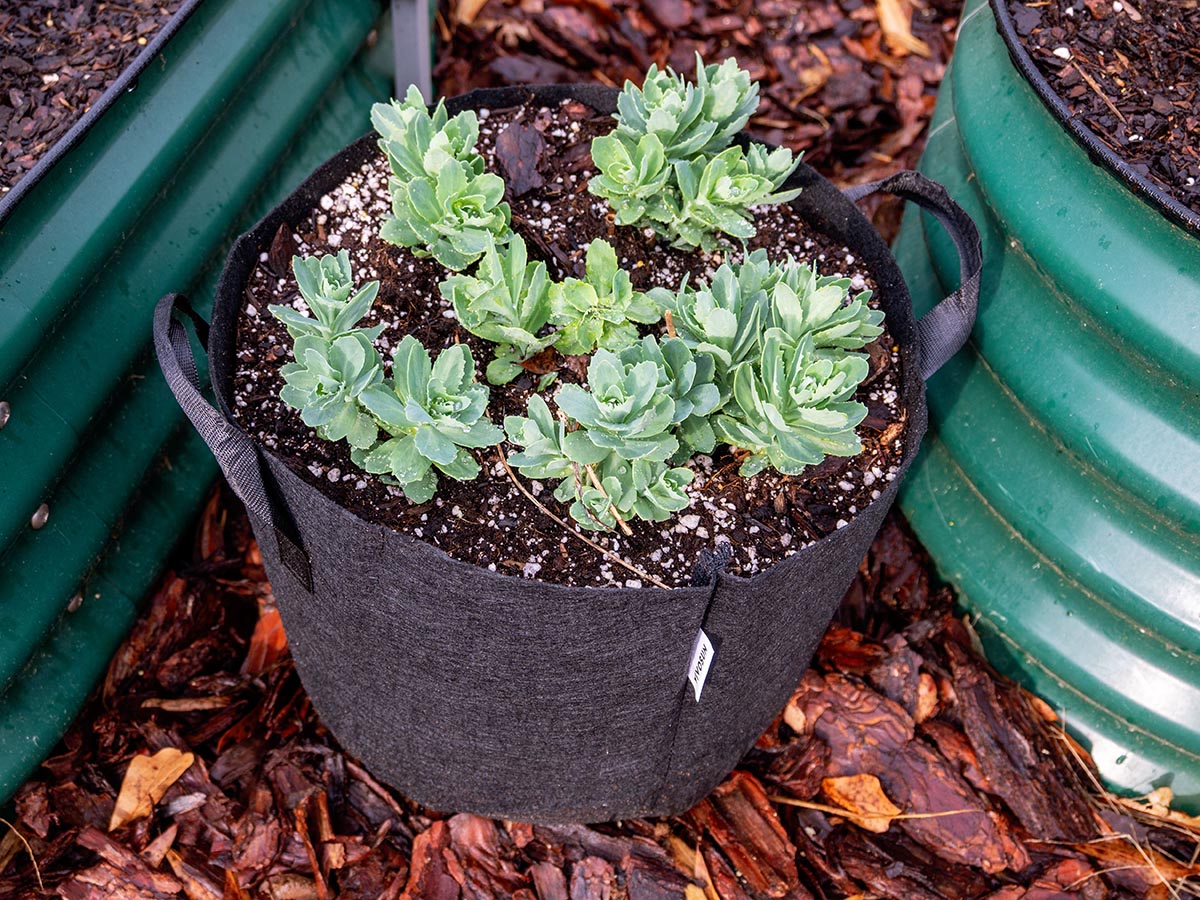
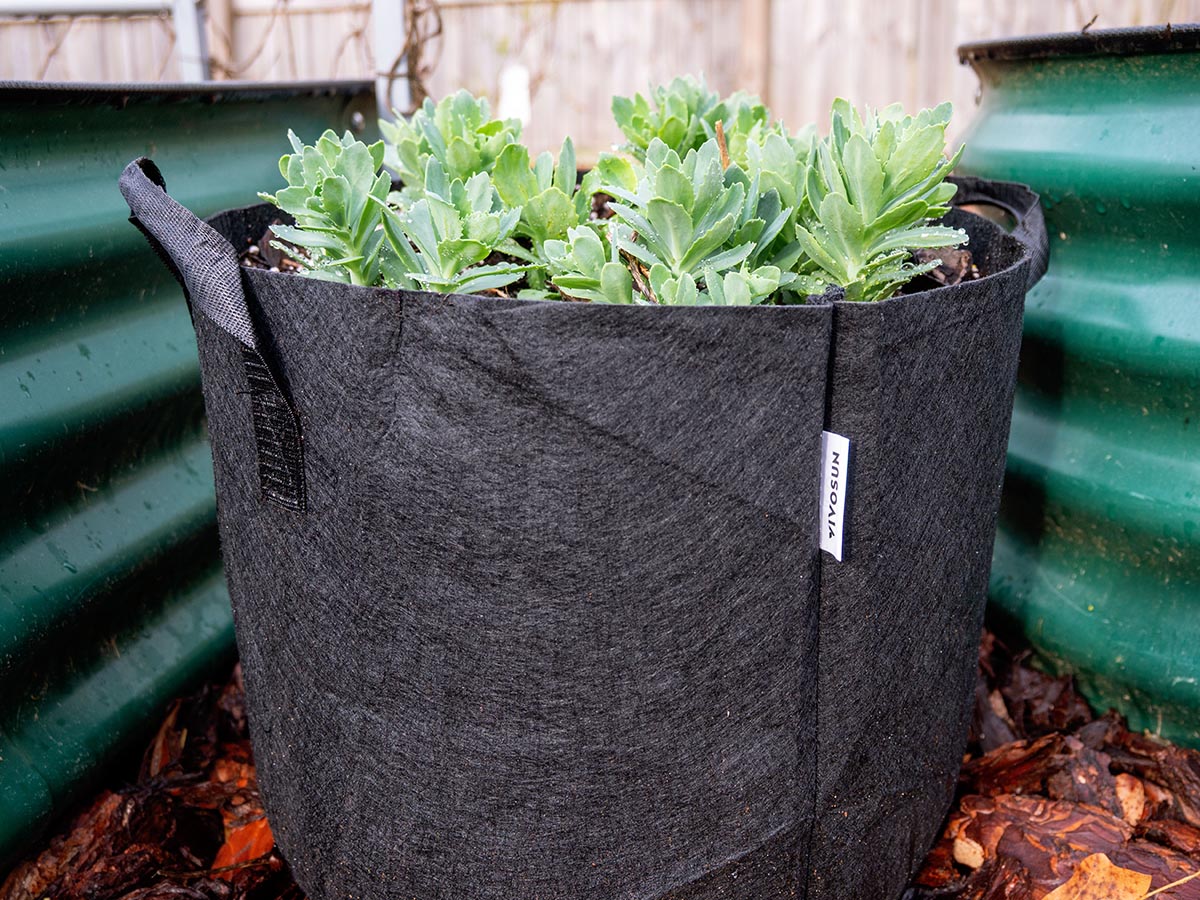
Our Top Picks
Among the top picks for the best grow bags are bags with some of the “extras” described: reinforced handles, hook-and-loop closures for easy opening, and irrigation channels that allow gardeners to install watering systems. Included are bags of various sizes to accommodate a variety of needs.
Best Overall
Vivosun 5-Gallon Nonwoven Fabric Grow Bags
What We Like
- Equipped with sturdy handles for easy movement
- Made from tear-resistant nonwoven fabric
- Cost-effective option
What We Don’t Like
- Fabric doesn’t feel as thick as similar products
Specs
- Material: 300g nonwoven fabric
- Dimension: 12.5 inches high by 9.9 inches wide
- Capacity: 5 gallons
Our Ratings: Durability 4/5; Portability 5/5; Functionality 5/5; Value 5/5
A quality, affordable option for gardeners, the 5-gallon size of these grow bags from Vivosun makes them a versatile choice for various planting needs. We found these bags especially useful as a temporary alternative to traditional nursery pots, allowing us to manage our space and seasonal gardening activities more efficiently.
The Vivosun grow bags offer great value for their price. The portability of these bags is a significant plus. They are easy to move around thanks to their sturdy handles, which were helpful as we relocated our sedum as the weather changed. Their breathable fabric promotes healthy root growth by ensuring good air circulation and drainage.
We noted only one drawback. Despite claims of being made from “heavy-duty 300G thickened nonwoven fabric,” they seemed thinner to us than similar products from other brands. This raises concerns about their long-term durability and robustness, particularly when used for heavier or more demanding plantings. While they perform well for light to medium-duty tasks, one might want to consider sturdier options for more intensive gardening projects.
Overall, we found the Vivosun 5-gallon grow bags to be a practical and cost-effective solution for temporary plantings and seasonal gardening. They stand out for their affordability and functionality, though they may not meet expectations for thickness and durability compared to other higher-end options on the market.
What our tester says: “I love how lightweight the Vivosun grow bags are. I moved them around my patio garden easily, even when full, and my plants thrived with the excellent drainage.”—Debbie Wolfe, Product Reviews tester and writer
Get the 5-gallon Vivosun grow bags at Amazon or Vivosun.
Best Bang for the Buck
Jnyong 12-Pack 10-Gallon Nonwoven Grow Bags
What We Like
- Made with nonwoven fabric, excellent air circulation
- Equipped with sturdy handles
- Impressive cost value
What We Don’t Like
- Less rigid than similar planting bags
Specs
- Material: Nonwoven fabric
- Dimension: 12 inches high by 16 inches wide
- Capacity: 10 gallons
Our Ratings: Durability 4/5; Portability 5/5; Functionality 5/5; Value 5/5
Made from nonwoven fabric, the Jnyong grow bags facilitate excellent breathability and proper water drainage, both of which are crucial for preventing moisture damage. We’ve specifically used the Jnyong bags to hold transplanted perennial herb cuttings we took over the winter. We plan to relocate these easily as the weather warms up, thanks to the sturdy handles that make transporting bags filled with wet soil a breeze.
However, one major drawback we’ve noticed with the Jnyong grow bags, unlike others we’ve tested, is their lack of rigidity. These bags feel less stable even when full of soil, which might concern gardeners who need more plant support. Despite this, the benefits of the fabric—like resisting damage from root rot and promoting healthier plant roots due to better aeration—outweigh this downside for most of our applications.
The Jnyoung fabric grow bags met our expectations for what a good grow bag should offer. They are affordable, functional, and particularly suited for plants that don’t require extensive root space, such as herbs and lettuce. They are available in several other sizes/capacities to accommodate large plants. Their reusability and ease of cleaning also make them an environmentally friendly option for our gardening projects.
Get the Jnyoung grow bags at Amazon.
Upgrade Pick
Epic Gardening Lined Grow Bags
What We Like
- Breathable fabric promotes healthy root growth
- Built-in irrigation strip
- Durable handles for easy transport
- Made from recycled material
What We Don’t Like
- Lining may degrade after multiple seasons
Specs
- Material: Recycled PET felt
- Dimension: 11.75 inches high by 19.5 inches wide
- Capacity: 15 gallons
Our Ratings: Durability 4/5; Portability 5/5; Functionality 5/5; Value 4.5/5
These lined grow bags from Epic Gardening feature a breathable fabric exterior with a moisture-retaining liner, which balances proper drainage and consistent plant moisture levels. The bags come in several sizes; we opted to test the 15-gallon size, which is suitable for growing plants like peppers, eggplant, and tomatoes.
There’s a lot to like about these garden grow bags. One thing that stood out to us was the double-row stitching. These bags feel durable, and the quality is noticeably better than cheaper alternatives. Even when we filled one with wet soil and moved it across our mulched garden, the handles held up perfectly without signs of stress or tearing.
The fabric, which helps prevent root circling, allows for great air pruning, and the lined interior keeps plants from drying out too quickly. We appreciated the sturdy handles and the way the bags fold flat for storage. However, they’re still grow bags—so expect to water frequently, especially during heat waves. While the lining helps retain moisture, it’s not a substitute for daily attention in hot climates. And if you’re growing larger plants, these might not offer the same structure as a hard-sided container. Still, for what they are, these grow bags are a dependable, reusable, and eco-friendly option we’ll continue using in our garden.
What our tester says: “These are the nicest potting bags for plants I’ve used. The liner really made a difference in keeping my plants happy between waterings, and I loved how durable the stitching felt. I fully expect them to last for multiple seasons.”—Debbie Wolfe, Product Reviews tester and writer
Get the Epic Gardening grow bags at Amazon and Epic Gardening.
Best Large
Smart Pots Big Bag Bed Fabric Raised Planting Bed
What We Like
- Ample room for vegetables, herbs, or flowers
- Made from tough weather-resistant fabric
- Promotes excellent drainage and aeration
What We Don’t Like
- Nearly impossible to move when filled
Specs
- Material: Nonwoven polypropylene fabric
- Dimension: 12 inches high by 36 inches wide
- Capacity: 50 gallons
Our Ratings: Durability 5/5; Portability 3/5; Functionality 4/5; Value 4.5/5
Smart Pots’ Big Bag Bed, a fabric-based raised planting bed, is an excellent no-fuss alternative to traditional raised garden beds. Made from durable, breathable fabric, this circular bed unfolds to create a 50-gallon planting space—no tools, assembly, or frames required. It promotes excellent drainage and root aeration, making it ideal for growing vegetables, herbs, and flowers. When the season’s over, it folds up flat for easy storage, making it a convenient choice for gardeners with limited space or those looking for a temporary setup.
We tested the Big Bag Bed in a backyard with notoriously poor clay soil, and it performed beautifully. The setup couldn’t have been easier—just unfold it, add soil, and start planting. The fabric allowed for great drainage even after heavy rains, and our plants thrived in the loose, well-aerated environment. It’s a great solution for gardeners who need to get above bad native soil or want to set up a seasonal garden without the commitment of a permanent raised bed.
The only downside we had was that once it was full of soil, it was nearly impossible to move. There are no handles, and the weight is substantial. So be sure to place it exactly where you want it before filling it up. Still, for a flexible and functional planting bed, especially in tough soil conditions, this is a smart, affordable choice.
Get the Smart Pots grow bag at Amazon or Smart Pots.
More Great Options
While we didn’t test these firsthand, two grow bags impressed us based on their features and positive user reviews. These picks are smartly designed and feature quality materials that customers are largely happy with, making them worthy alternatives to consider.
Best Small
Vivosun 1-Gallon Grow Bags with Self-Adhesion Sides
What We Like
- Breathable fabric encourages healthy roots
- Side seams make emptying soil easy
- Affordable multi-pack option
What We Don’t Like
- No handles may make it difficult to move
Specs
- Material: Nonwoven fabric
- Dimension: 7.9 inches high by 6.3 inches wide
- Capacity: 1 gallon
These 1-gallon Vivosun bags are ideal for starting plants for outdoor transplanting or for growing smaller plants. They have a hook-and-loop closure on one side, which “unwraps” the bag and makes it easy to transplant flowers, herbs, and veggies. The bags’ material is BPA-free, offers ample drainage, and can be reused. They don’t have handles, which is inconvenient but not a dealbreaker because the bags are small. Made of nonwoven fabric, the bags measure almost 8 inches high and approximately 6.3 inches in diameter.
Get the Vivosun 1-gallon grow bags at Amazon.
Best in Bulk
Jeria 12-Pack 7-Gallon Vegetable/Flower/Plant Bags
What We Like
- Cost-effective for larger gardening projects
- Reinforced handles for easy lifting and transport
- Ample space for growing a variety of plants
What We Don’t Like
- May not stand upright until filled
Specs
- Material: Not Listed
- Dimension: 12 inches high by 13 inches wide
- Capacity: 7 gallons
Jeria’s 7-gallon grow bags come with reinforced handles, and each bag measures 12 inches high by 13 inches wide. The bags are made with nonwoven fabric so the soil can drain and aerate. Because the bags have handles and are made of sturdy material, they are relatively easy to move, even when filled with soil. This 12-pack of bags also comes with 12 plant tags for labeling the plants.
The bags are washable and can be reused. The 7-gallon size is ideal for plants that need a lot of root space, such as melons, indeterminate tomatoes, squash, and even smaller fruit trees.
Get the Jeria grow bags at Amazon.
Jump to Our Top Picks
How We Chose and Tested the Best Grow Bags
| Products tested | 4 |
| Time spent testing | 1 month |
| Tests performed | 3 |
| Price range | $13 to $43 |
We considered more than a dozen products from various brands to find the best grow bags, evaluating them based on key features like material quality, size options, handle strength, price, and customer reviews. We narrowed down this initial set of contenders to four standout products for hands-on testing.
Each grow bag was filled with potting soil and used to grow plants over several weeks to assess real-world performance. We scored each on durability, functionality, portability, and overall value. To evaluate functionality, we observed how well the bags supported healthy plant growth, retained moisture, and allowed for adequate drainage and airflow. We also evaluated portability and ease of use when lifting and moving bags, especially when filled. We tested durability by examining the stitching, handle strength, and fabric integrity after repeated watering, sun exposure, and repositioning. Each product received a score in every category, and we calculated an average rating to determine the overall value. Our top picks reflect a balance of affordability, usability, and consistent gardening performance.
| Durability | Portability | Functionality | Value | |
| Vivosun 5-Gallon Nonwoven Fabric Grow Bags | 4 | 5 | 5 | 5 |
| Jnyong 12-Pack 10-Gallon Nonwoven Grow Bags | 4 | 5 | 5 | 5 |
| Epic Gardening Lined Grow Bags | 4 | 5 | 5 | 4.5 |
| Smart Pots Big Bag Bed Fabric Raised Planting Bed | 5 | 3 | 4 | 4.5 |
What to Consider When Choosing a Grow Bag
Before shopping for the best grow bags, first consider what you plan to grow in them (the right soil and fertilizer are separate issues). The following are primary considerations when picking the right set of grow bags for your needs.
Material
Most grow bags are made of nonwoven fabric, which is typically bonded by using heat or chemicals. Nonwoven fabric makes an ideal material for grow bag construction because it’s usually more breathable than woven fabric, allowing plants to dry out between waterings and helping the soil to properly aerate. Healthy air circulation helps inhibit mold growth. The best grow bags are made of a nonwoven material that’s breathable yet sturdy enough to support the weight of the soil and the plant.
Size
Size is an essential consideration when shopping for the best grow bag. Grow bags vary in size from 1 gallon to more than 20 gallons. The grow bags on this list range up to 7 gallons in size, which is large enough to accommodate one pepper or tomato plant. The best grow bag for your needs depends on what you intend to plant. For example, a tomato plant needs at least 12 inches of soil, while radishes need only half that.
Aeration and Drainage
The best grow bag should drain water efficiently and allow the soil to aerate, which helps keep the roots healthy. One of the best things about grow bags is their ability to provide better air circulation and drainage than the same plant could receive in the ground.
The better a grow bag drains water and dries out, the more likely the bag can be reused. Grow bags that don’t drain well are subject to bacterial infections and mold growth.
Windows
Bags for growing potatoes come with plastic “windows” so gardeners can see the roots of the plant to help determine if the plant is ready for harvest. These are primarily useful for root vegetables, such as carrots, rutabegas, and of course, potatoes. A window that opens can also make harvesting vegetables much easier. For flowers or herbs, however, a window isn’t usually necessary.
Transplanting
If you plan on growing plants or seeds in grow bags to transplant later, look for bags with a hook-and-loop closure on the side of the grow bag. Unfastening these closures is a much easier way to remove a plant than turning the bag sideways and wiggling the plant out of its container.
Container gardening is beneficial for any flower, herb, or vegetable that won’t survive the entire gardening season, as the plants can be removed easily and brought indoors.
Portability
Portability is another important consideration. To avoid portability issues when gardening in grow bags, some shoppers mistakenly opt for smaller bags, but if the bags are too small for the plant, it won’t thrive. Rather than choosing bags that are too small, opt for ones designed with portability in mind. Many grow bags have handles to make them easier to carry and move. Though smaller grow bags are lighter weight because they hold less soil, the size can make them less hospitable to some plants, such as indeterminate tomato plants.
FAQs
While shopping for the best grow bags for plants, you may have questions about what you can and cannot do with these garden marvels. Some of the most frequently asked questions about grow bags appear below.
Unfortunately, no. Most grow bags aren’t suitable for plants like pumpkins, okra, and winter squash, all of which need a lot of root space.
Plants with shallow roots—such as peppers, lettuce, cucumbers, peas, radishes, and some herbs—can be grown successfully in 3-gallon grow bags.
If you’re using your grow bags outside, you might not need to put anything under them. However, if they’re inside or on a deck, place a saucer or plate underneath to catch the moisture that seeps through the fabric. Some gardeners put their grow bags on cinder blocks or wood stilts for better drainage.
No, most grow bags drain properly, although you may need to move the grow bag to prevent moisture from building up around the base.
With the right care, most grow bags can last for years.
Meet the Tester
Debbie Wolfe is a veteran garden writer and product reviewer with hands-on experience testing tools and gear for home gardeners. Her practical, detail-driven approach helps readers make informed buying decisions.
Additional research provided by Jenn Ryan.
